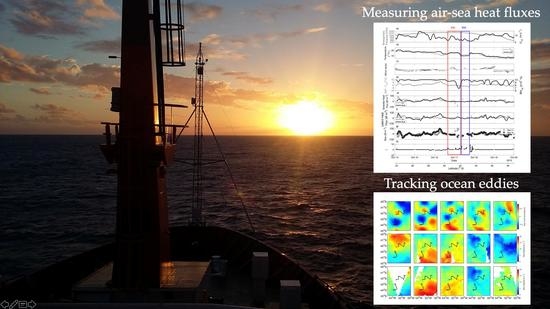Air-Sea Interactions over Eddies in the Brazil-Malvinas Confluence
Abstract
1. Introduction
2. Materials and Methods
2.1. Eddies Identification and Tracking
2.2. Satellite-Derived Wind Magnitudes and Atmospheric Reanalysis Time Series
2.3. The INTERCONF-32 Campaign
2.4. Bulk Parameterization and Eddy Covariance Measurements of Air-Sea Heat Fluxes
3. Results and Discussion
3.1. Eddies Identification and Tracking
3.2. Satellite-Derived Wind Magnitudes and Atmospheric Reanalysis Time Series
3.3. The INTERCONF-32 Campaign
3.4. Comparing ERA5 and In Situ Measurements of Heat Fluxes over ED1 and ED2
4. Conclusions
Author Contributions
Funding
Data Availability Statement
Acknowledgments
Conflicts of Interest
References
- Chelton, D.B.; Schlax, M.G.; Witter, D.L.; Richmann, J.G. GEOSAT altimeter observations of the surface circulation of the Southern Ocean. J. Geophys. Res. 1990, 95, 877–903. [Google Scholar] [CrossRef]
- Garzoli, S.; Simionato, C. Baroclinic instabilities and forced oscillations in the Brazil/Malvinas Confluence front. Deep-Sea Res. 1990, 37, 1053–1074. [Google Scholar] [CrossRef]
- Garcia, C.A.E.; Sarma, Y.V.B.; Mata, M.M.; Garcia, V.M.T. Chlorophyll variability and eddies in the Brazil–Malvinas Confluence region. Deep-Sea Res. 2004, 51, 159–172. [Google Scholar] [CrossRef]
- Souza, R.B.; Mata, M.M.; Garcia, C.A.; Kampel, M.; Oliveira, E.N.; Lorenzzetti, J.A. Multi-sensor satellite and in situ measurements of a warm core ocean eddy south of the Brazil-Malvinas Confluence region. Remote Sens. Environ. 2006, 100, 52–66. [Google Scholar] [CrossRef]
- Small, R.J.; DeSzoeke, S.P.; Xie, S.-P.; O’Neill, L.; Seo, H.; Song, Q.; Cornillon, P.; Spall, M.; Minobe, S. Air-sea interaction over ocean fronts and eddies. Dyn. Atmos. Oceans 2008, 45, 274–319. [Google Scholar] [CrossRef]
- Chelton, D.B.; Xie, S.-P. Coupled ocean–atmosphere interaction at oceanic mesoscales. Oceanography 2010, 23, 52–69. [Google Scholar] [CrossRef]
- Rouault, M.; Veley, P.; Backeberg, B. Wind changes above warm Agulhas Current eddies. Ocean. Sci. 2016, 12, 495–506. [Google Scholar] [CrossRef]
- Leyba, I.M.; Saraceno, M.; Solman, S.A. Air-sea fluxes associated to mesoscale eddies in the Southwestern Atlantic Ocean and their dependence on different regional conditions. Clim. Dyn. 2017, 49, 2491–2501. [Google Scholar] [CrossRef]
- Gentemann, C.L.; Clayson, C.A.; Brown, S.; Lee, T.; Parfitt, R.; Ferrar, J.T.; Bourassa, M.; Minnett, P.; Seo, H.; Gille, S.T.; et al. FluxSat: Measuring the ocean-atmosphere turbulent exchange of heat and moisture from space. Remote Sens. 2020, 12, 1796. [Google Scholar] [CrossRef]
- Pezzi, L.P.; Souza, R.B.; Santini, M.F.; Miller, A.J.; Carvalho, J.T.; Parise, C.K.; Quadro, M.F.; Rosa, E.B.; Justino, F.; Sutil, U.A.; et al. Oceanic eddy-induced modifications on the air-sea heat and CO2 fluxes in the Brazil-Malvinas Confluence. Sci. Rep. 2020. in revision. [Google Scholar]
- Lindzen, R.S.; Nigam, S. On the role of sea surface temperature gradients in forcing low-level winds and convergence in the tropics. J. Atmos. Sci. 1987, 44, 2418–2436. [Google Scholar] [CrossRef]
- Hayes, S.P.; McPhaden, M.J.; Wallace, J.M. The influence of sea surface temperature on surface wind in the eastern equatorial Pacific: Weekly to monthly variability. J. Clim. 1989, 2, 1500–1506. [Google Scholar] [CrossRef]
- Wallace, J.M.; Mitchell, T.P.; Deser, C.J. The influence of sea-surface temperature on surface wind in the Eastern Equatorial Pacific: Weekly to monthly variability. J. Clim. 1989, 2, 1492–1499. [Google Scholar] [CrossRef]
- Pezzi, L.P.; Souza, R.B.; Dourado, M.S.; Garcia, C.A.E.; Mata, M.M.; Silva Dias, M.A.F. Ocean-atmosphere in situ observations at the Brazil-Malvinas Confluence region. Geophys. Res. Lett. 2005, 32. [Google Scholar] [CrossRef]
- Pezzi, L.P.; Souza, R.B.; Acevedo, O.; Wainer, I.E.K.; Mata, M.M.; Garcia, C.A.E.; Camargo, R. Multi-year measurements of the Oceanic and Atmospheric Boundary Layers at the Brazil-Malvinas Confluence Region. J. Geophys. Res. 2009, 114. [Google Scholar] [CrossRef]
- Santini, M.F.; Souza, R.B.; Pezzi, L.P.; Swart, S. Observations of air-sea heat fluxes in the southwestern Atlantic under high-frequency ocean and atmospheric perturbations. Q. J. R. Meteorol. Soc. 2020, 146, 4226–4251. [Google Scholar] [CrossRef]
- Tokinaga, H.; Tanimoto, Y.; Xie, S.P. SST-induced wind variations over Brazil/Malvinas Confluence: Satellite and in-situ observations. J. Clim. 2005, 18, 3470–3482. [Google Scholar] [CrossRef]
- Gramcianinov, C.B.; Hodges, K.I.; Camargo, R. The properties and genesis environments of South Atlantic cyclones. Clim. Dyn. 2019, 53, 4115–4140. [Google Scholar] [CrossRef]
- Gan, M.A.; Rao, V.B. Surface cyclogenesis over South America. Mon. Weather Rev. 1991, 119, 1293–1302. [Google Scholar] [CrossRef]
- Reboita, M.S.; da Rocha, R.P.; Ambrizzi, T.; Sugahara, S. South Atlantic Ocean cyclogenesis climatology simulated by regional climate model (RegCM3). Clim. Dyn. 2010, 35, 1331–1347. [Google Scholar] [CrossRef]
- Dias Pinto, J.R.; da Rocha, R.P. The energy cycle and structural evolution of cyclones over southeastern South America in three case studies. J. Geophys. Res. 2011, 116, D14112. [Google Scholar] [CrossRef]
- Evans, J.L.; Braun, A. A Climatology of Subtropical Cyclones in the South Atlantic. J. Clim. 2012, 25, 7328–7340. [Google Scholar] [CrossRef]
- Gozzo, L.F.; da Rocha, R.P.; Reboita, M.S.; Sugahara, S. Subtropical Cyclones over the Southwestern South Atlantic: Climatological aspects and case study. J. Clim. 2014, 27, 8543–8562. [Google Scholar] [CrossRef]
- Acevedo, O.C.; Pezzi, L.P.; Souza, R.B.; Anabor, V.; Degrazia, G.A. Atmospheric boundary layer adjustment to the synoptic cycle at the Brazil-Malvinas Confluence, South Atlantic Ocean. J. Geophys. Res. Atmos. 2010, 115, 1–12. [Google Scholar] [CrossRef]
- De Camargo, R.; Todesco, E.; Pezzi, L.P.; Souza, R.B. Modulation mechanisms of marine atmospheric boundary layer at the Brazil-Malvinas Confluence region. J. Geophys. Res. Atmos. 2013, 118, 6266–6280. [Google Scholar] [CrossRef]
- Hackerott, J.A.; Pezzi, L.P.; Bakhoday Paskyabi, M.; Oliveira, A.P.; Reuder, J.; Souza, R.B.; Camargo, R. The role of roughness and stability on the momentum flux in the Marine Atmospheric Surface Layer: A study on the Southwestern Atlantic Ocean. J. Geophys. Res. 2018, 123, 3914–3932. [Google Scholar] [CrossRef]
- Sugimoto, S.; Aono, K.; Fukui, S. Local atmospheric response to warm mesoscale ocean eddies in the Kuroshio-Oyashio Confluence region. Sci. Rep. 2017, 7, 11871. [Google Scholar] [CrossRef] [PubMed]
- Oliveira, F.S.C.; Polito, P.S. Mesoscale eddy detection in satellite imagery of the oceans using the Radon transform. Prog. Oceanogr. 2018, 167, 150–163. [Google Scholar] [CrossRef]
- Henson, S.A.; Thomas, A.C. A census of oceanic anticyclonic eddies in the Gulf of Alaska. Deep-Sea Res. Part I 2008, 55, 163–176. [Google Scholar] [CrossRef]
- Chang, Y.L.; Oey, L.Y. Analysis of STCC eddies using the Okubo–Weiss parameter on model and satellite data. Ocean Dyn. 2014, 64, 259–271. [Google Scholar] [CrossRef]
- Frenger, I.; Gruber, N.; Knutti, R.; Münnich, M. Imprint of Southern Ocean eddies on winds, clouds and rainfall. Nat. Geosci. 2013, 6, 608–612. [Google Scholar] [CrossRef]
- Chelton, D.; Schlax, M.G.; Samelson, R.M.; Szoeke, R.A. Global observations of large oceanic eddies. Geophys. Res. Lett. 2007, 34, l15606. [Google Scholar] [CrossRef]
- Lentini, C.A.D.; Olson, D.B.; Podestá, G. Statistics of Brazil Current rings observed from AVHRR: 1993 to 1998. Geophys. Res. Lett. 2002, 29, 58-1–58-4. [Google Scholar] [CrossRef]
- Volkov, D.L.; Fu, L.-L. The role of vorticity fluxes in the dynamics of the Zapiola Anticlyclone. Geophys. J. Geophys. Res. 2008, 113, C11015. [Google Scholar] [CrossRef]
- Saraceno, M.; Provost, C.; Zajaczkovski, U. Long-term variation in the anticyclonic ocean circulation over the Zapiola Rise as observed by satellite altimetry: Evidence of possible collapses. Deep-Sea Res. Part I 2009, 56, 1077–1092. [Google Scholar] [CrossRef]
- Oliveira, L.R.; Piola, A.R.; Mata, M.M.; Soares, I.D. Brazil Current surface circulation and energetics observed from drifting buoys. J. Geophys. Res. 2009, 114, C10006. [Google Scholar] [CrossRef]
- Fratini, F.; Ibrom, A.; Arriga, N.; Burba, G.; Papale, D. Relative humidity effects of water vapour fluxes measured with closed-path eddy-covariance systems with short sampling lines. Agric. For. Meteorol. 2012, 165, 53–63. [Google Scholar] [CrossRef]
- Edson, J.B.; Jampana, V.; Weller, R.A.; Bigorre, S.P.; Plueddemann, A.J.; Fairall, C.W.; Miller, S.D.; Mahrt, L.; Vickers, D.; Hersbach, H. On the Exchange of Momentum over the Open Ocean. J. Phys. Oceanogr. 2013, 43, 1589–1610. [Google Scholar] [CrossRef]
- Miller, S.D.; Hristov, T.S.; Edson, J.B.; Friehe, C.A. Platform motion effects on measurements of turbulence and air-sea exchange over the open ocean. J. Atmos. Ocean. Technol. 2008, 25, 1683–1694. [Google Scholar] [CrossRef]
- Fujitani, T. Direct measurement of turbulent fluxes over the sea during AMTEX. Pap. Meteorol. Geophys. 1981, 32, 119–134. [Google Scholar] [CrossRef]
- Edson, J.B.; Hinton, A.A.; Prada, K.E.; Hare, J.E.; Fairall, C.W. Direct covariance flux estimates from mobile platforms at sea. J. Atmos. Ocean. Technol. 1998, 15, 547–562. [Google Scholar] [CrossRef]
- McGilis, W.R.; Edson, J.B.; Hare, J.E.; Fairall, C.W. Direct covariance air–sea CO2 fluxes. J. Geophys. Res. 2001, 106, 16729–16745. [Google Scholar] [CrossRef]
- Miller, S.D.; Marandino, C.; Saltzman, E.S. Ship-based measurement of air–sea CO2 exchange by eddy covariance. J. Geophys. Res. 2010, 115, 1–14. [Google Scholar] [CrossRef]
- Flügge, M.; Edson, J.B.; Reuder, J. Sensor movement correction for direct turbulence measurements in the marine atmospheric boundary layer. Energy Procedia 2012, 24, 159–165. [Google Scholar] [CrossRef]
- Martins, L.G.N.; Miller, S.D.; Acevedo, O.C. Using empirical mode decomposition to filter out non-turbulent contributions to air–sea fluxes. Bound. Layer Meteorol. 2016, 163, 123. [Google Scholar] [CrossRef]
- Fairall, C.W.; Bradley, E.F.; Rogers, D.P.; Edson, J.B.; Young, G.S. Bulk parameterization of air-sea fluxes for Tropical Ocean-Global Atmosphere Coupled-Ocean Atmosphere Response Experiment. J. Geophys. Res. Oceans 1996, 101, 3747–3764. [Google Scholar] [CrossRef]
- Stull, R.B. An Introduction to Boundary Layer Meteorology; Kluwer Academic Publishers: Dordrecht, The Netherlands, 1988; 666p. [Google Scholar]
- Aubinet, M.; Vesala, T.; Papale, D. (Eds.) Eddy Covariance: A Practical Guide to Measurement and Data Analysis; Atmospheric Sciences; Springer: Berlin, Germany, 2012; ISBN 978-94-007-2351-1. [Google Scholar]
- Pattey, E.; Strachan, I.B.; Desjardins, R.L. Measuring nighttime CO2 flux over terrestrial ecosystems using eddy covariance and nocturnal boundary layer methods. Agric. For. Meteorol. 2002, 113, 145–158. [Google Scholar] [CrossRef]
- Yusup, Y.; Liu, H. Effects of atmospheric surface layer stability on turbulent fluxes of heat and water vapor across the water-atmosphere interface. J. Hidrometeorol. 2016, 17, 2835–2851. [Google Scholar] [CrossRef]
- Sun, Y.; Jia, L.; Chen, Q.; Zheng, C. Optimizing window length for turbulent heat flux calculations from airborne eddy covariance measurements under near neutral to unstable atmospheric stability conditions. Remote Sens. 2018, 10, 670. [Google Scholar] [CrossRef]
- Legeckis, R.; Gordon, A.L. Satellite observations of the Brazil and Falkland Currents—1975 to 1976 and 1978. Deep-Sea Res. 1982, 29, 375–401. [Google Scholar] [CrossRef]
- Bharti, V.; Fairall, C.W.; Blomquist, B.W.; Huang, Y.; Protat, A.; Sullivan, P.P.; Siems, S.T.; Manton, M.J. Air-sea heat and momentum fluxes in the Southern Ocean. J. Geophys. Res. Atmos. 2019, 124, 12426–12443. [Google Scholar] [CrossRef]
- Villas Bôas, A.B.; Sato, O.T.; Chaigneau, A.; Castelão, G.P. The signature of mesoscale eddies on the air-sea turbulent heat fluxes in the South Atlantic Ocean. Geophys. Res. Lett. 2015, 42, 1856–1862. [Google Scholar] [CrossRef]
- Messager, C.; Swart, S. Significant atmospheric boundary layer change observed above an Agulhas Current warm cored eddy. Adv. Meteorol. 2016, 2016, 3659657. [Google Scholar] [CrossRef]
- Bouin, M.-N.; Caniaux, G.; Traullé, O.; Legain, D.; Le Moigne, P. Long-term heat exchanges over a Mediterranean lagoon. J. Geophys. Res. 2012, 117, D23104. [Google Scholar] [CrossRef]
- Marion, J.R. Providing the Best Turbulent Heat Flux Estimates from Eddy Correlation and Bulk Methods Using DYNAMO Data. Ph.D. Thesis, Oregon State University, Corvallis, OR, USA, 2014. [Google Scholar]
- Blomquist, B.W.; Huebert, B.J.; Fairall, C.W.; Bariteau, L.; Edson, J.B.; Hare, J.E.; McGillis, W.R. Advances in Air-Sea CO2 Flux Measurement by Eddy Correlation. Bound. Layer Meteorol. 2014, 152, 245–276. [Google Scholar] [CrossRef]
- Butterworth, B.J.; Miller, S.D. Automated underway eddy covariance system for air-sea momentum, heat, and CO2 fluxes in the Southern Ocean. J. Atmos. Oceans Technol. 2016, 33, 635–652. [Google Scholar]
- Bourassa, M.A.; Gille, S.T.; Bitz, C.; Carlson, D.; Cerovecki, I.; Clayson, C.A.; Cronin, M.F.; Drennan, W.M.; Fairall, C.W.; Hoffman, R.N.; et al. High-latitude ocean and sea ice surface fluxes: Challenges for climate research. Bull. Am. Meteorol. Soc. 2013, 94, 403–423. [Google Scholar] [CrossRef]
- Fairall, C.; Hare, J.; Edson, J.; Mcgilllis, W. Parameterization and micrometeorological measurement of air-sea gas transfer. Bound. Layer Meteorol. 2000, 96, 63–105. [Google Scholar] [CrossRef]
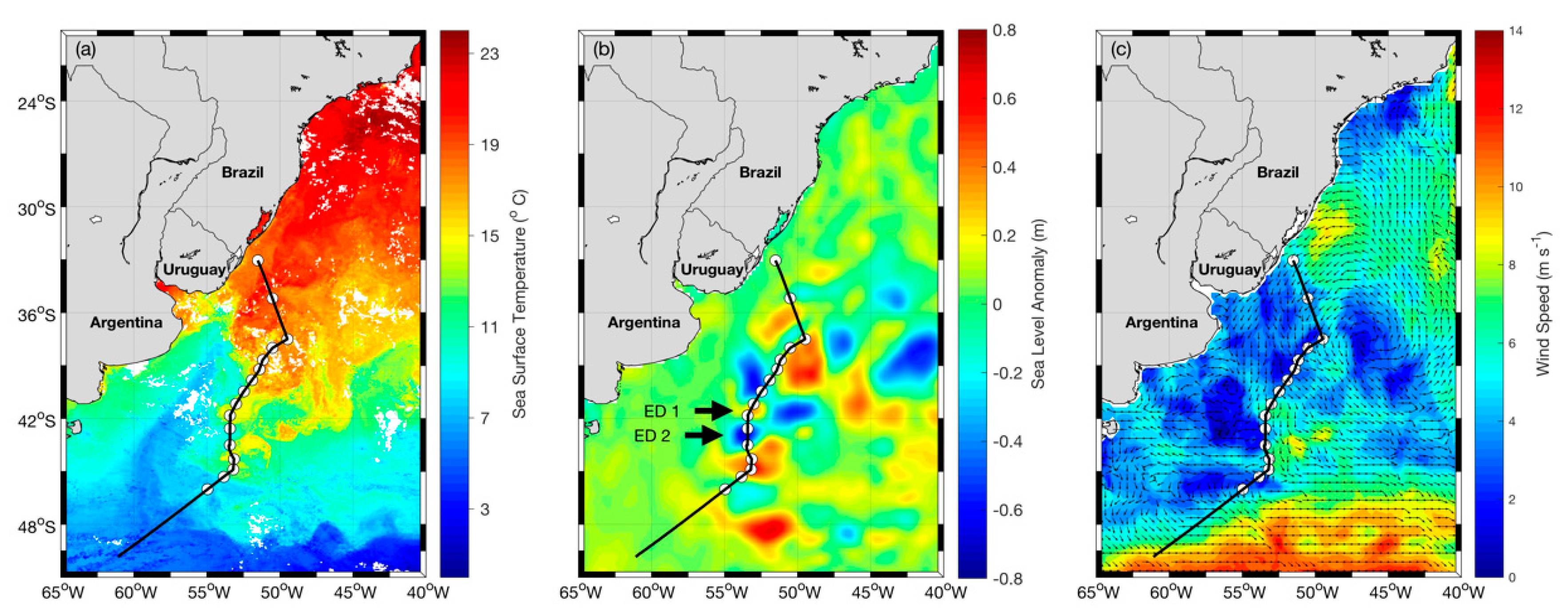
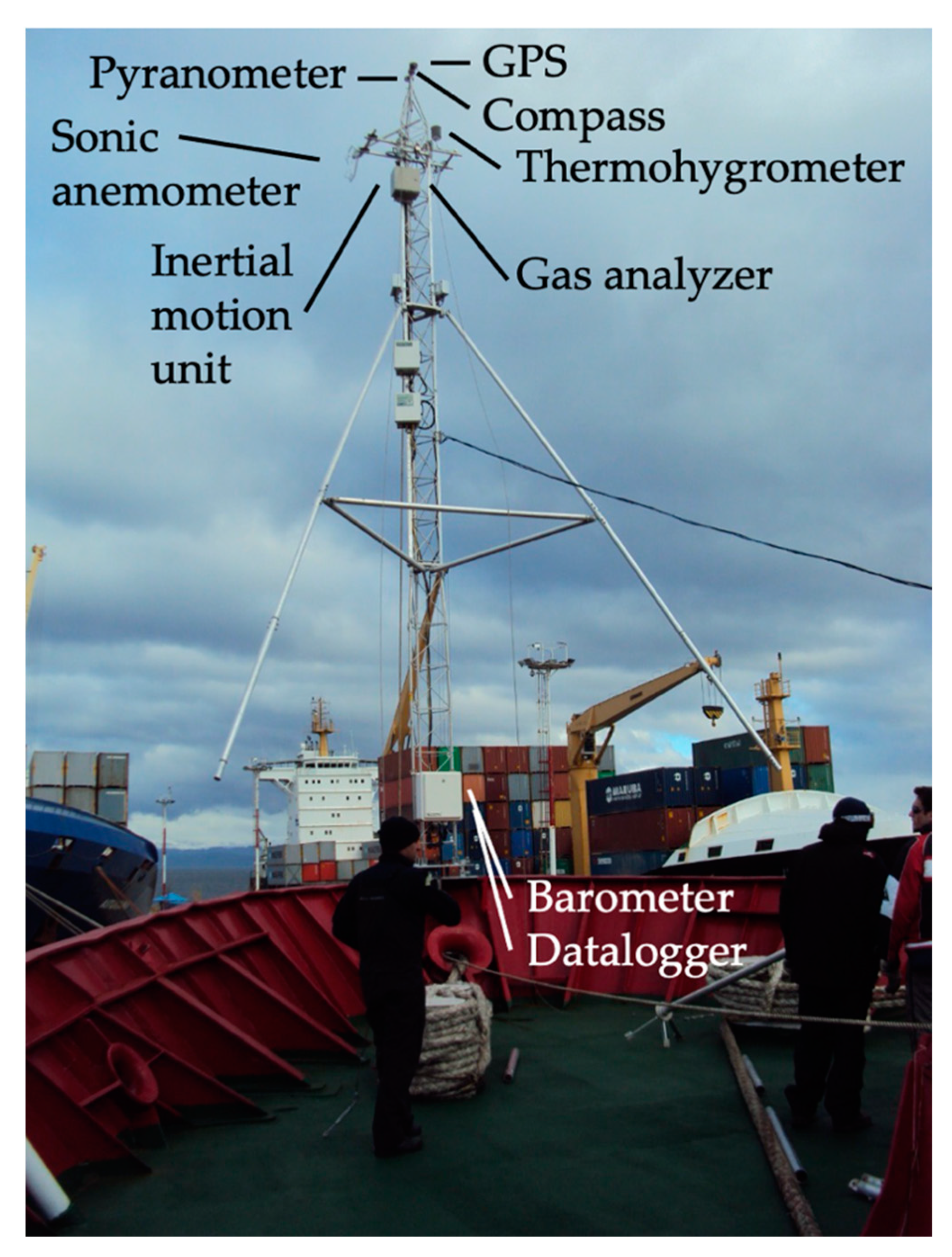
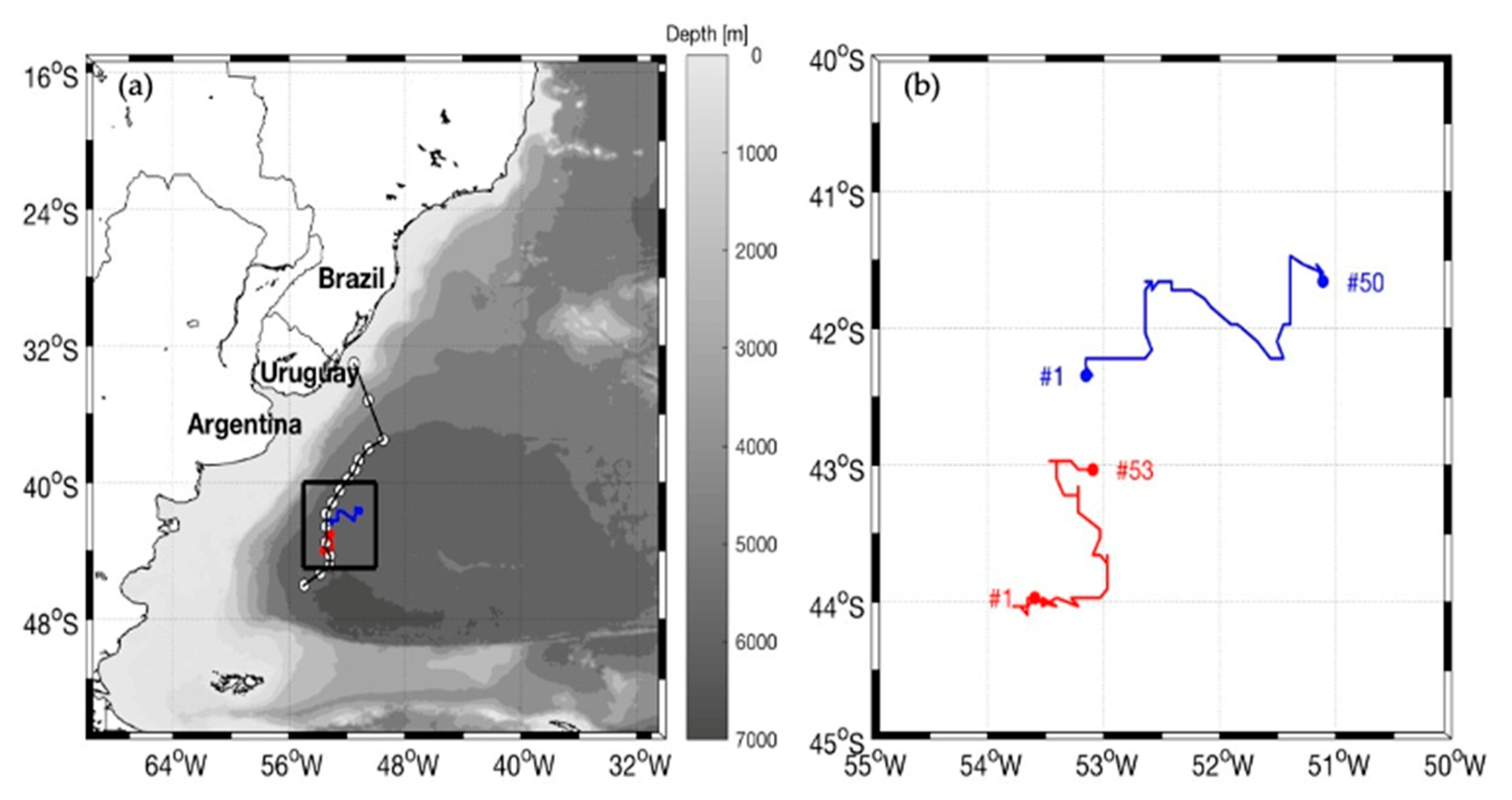
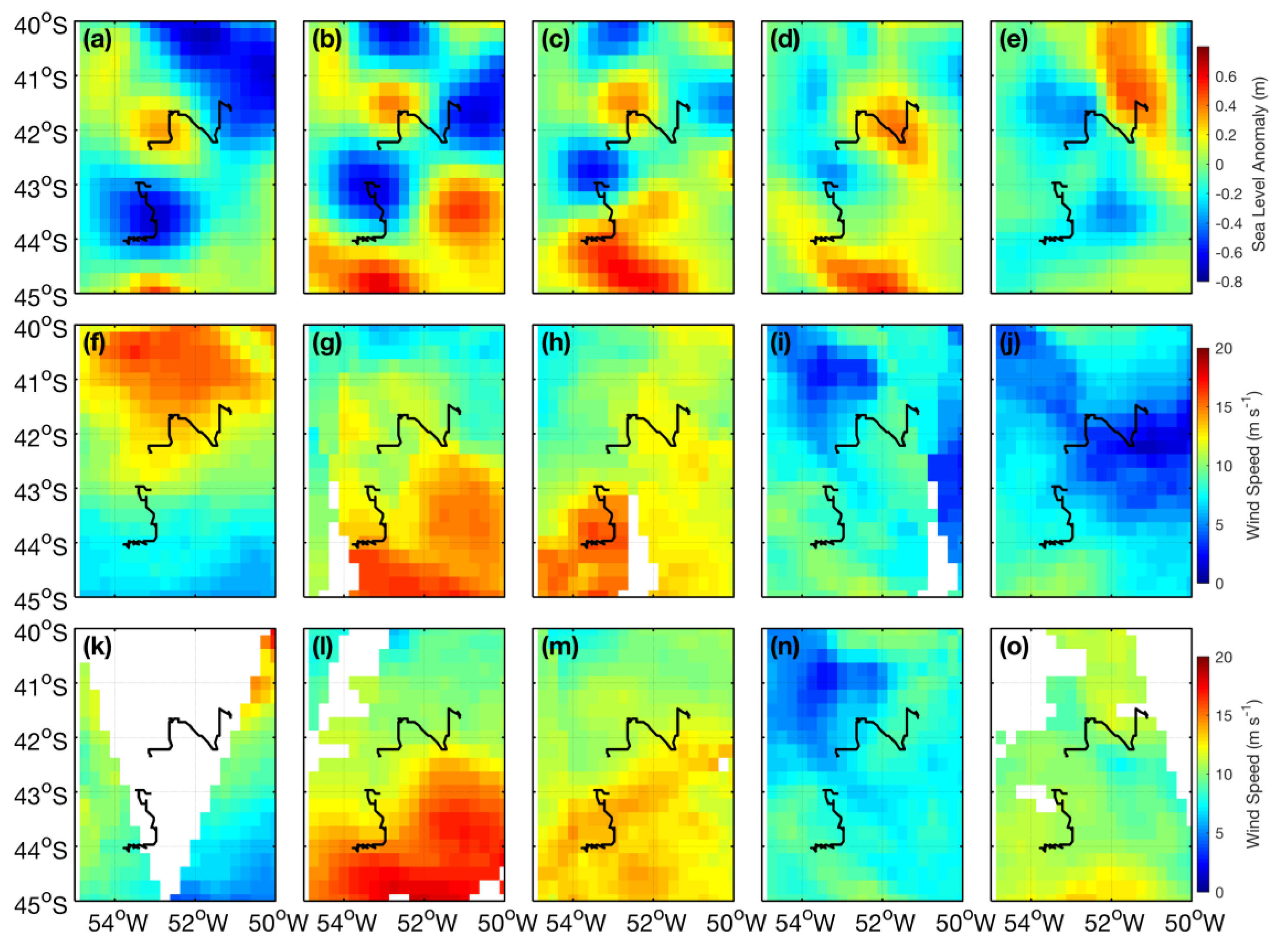
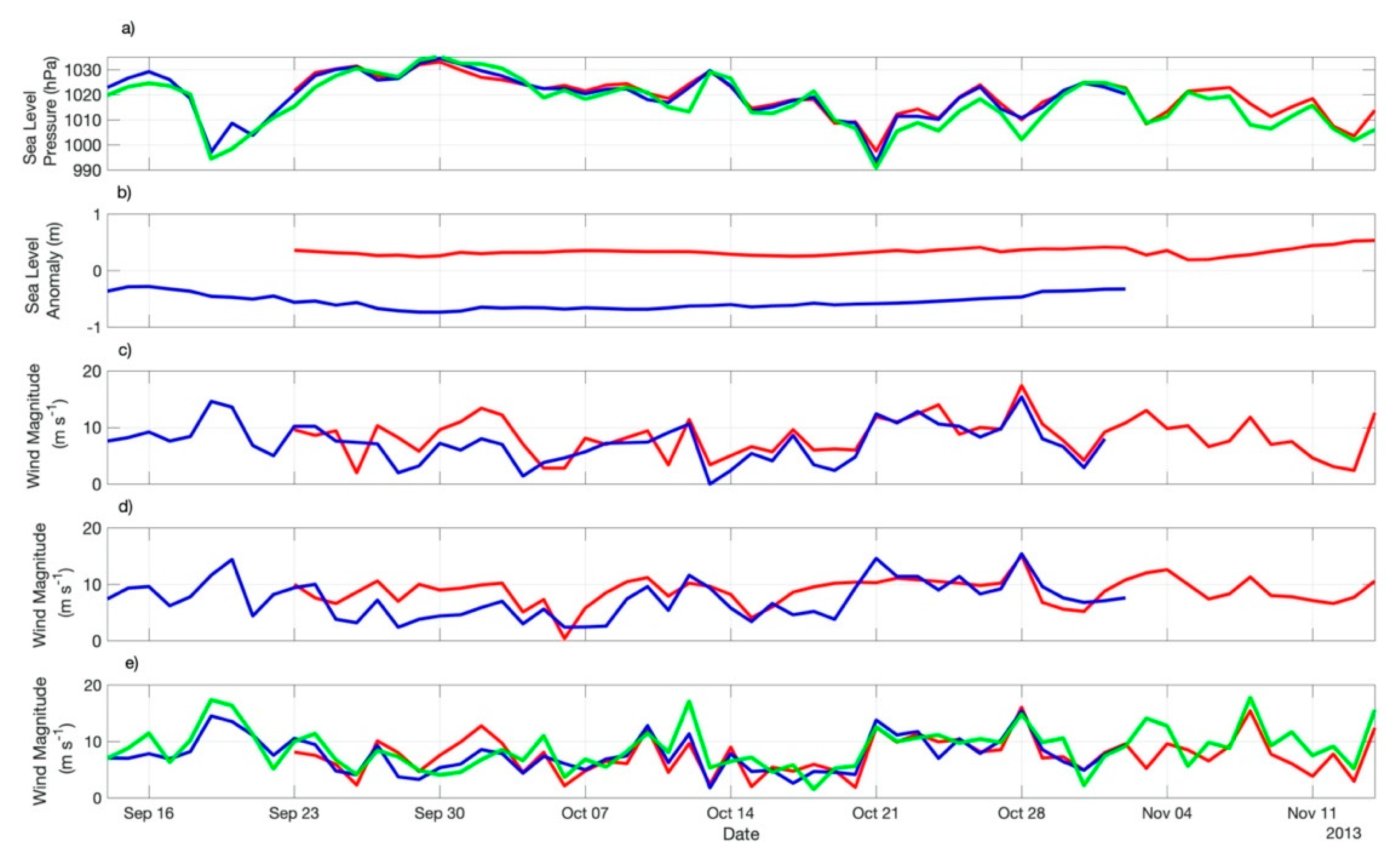
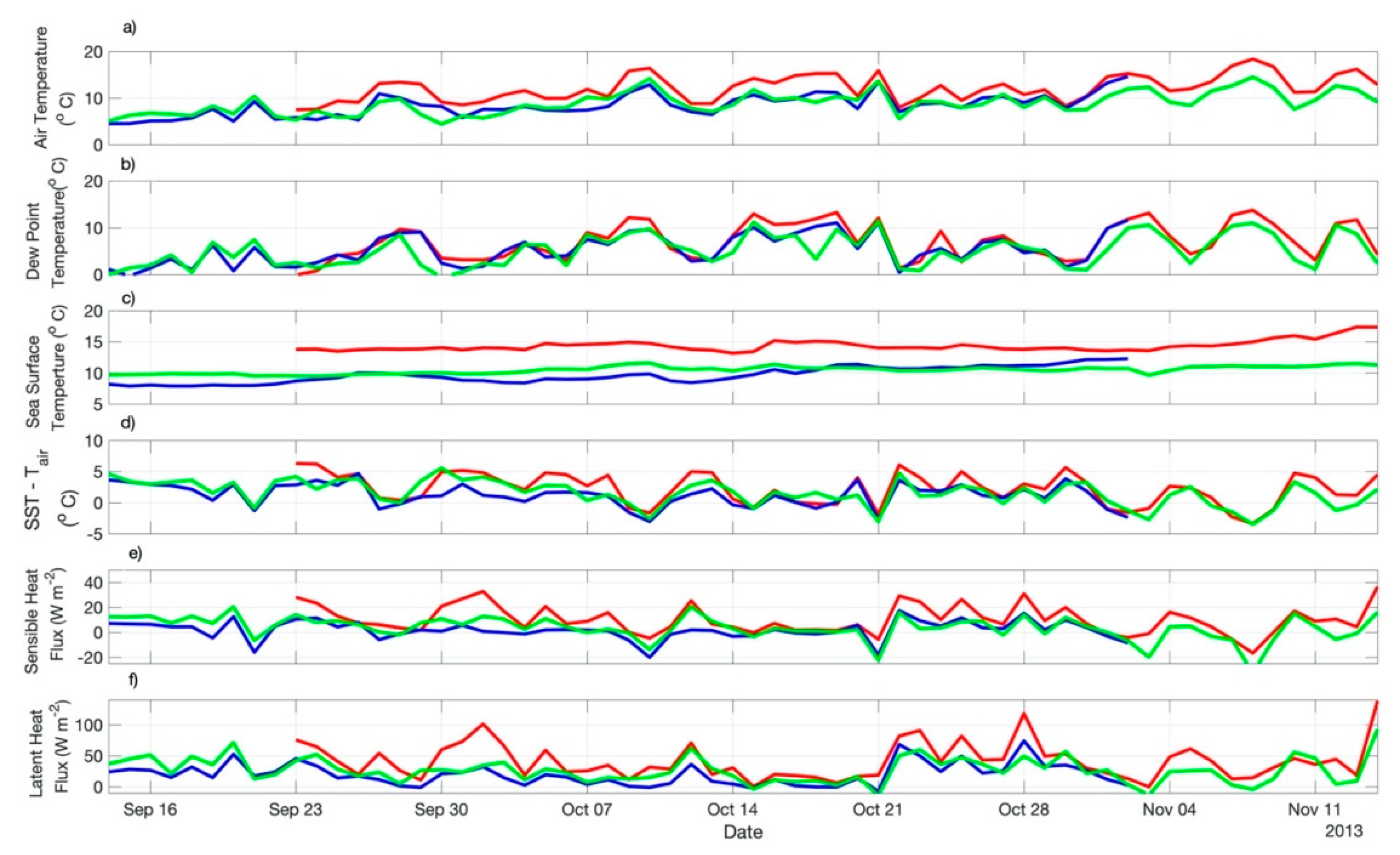
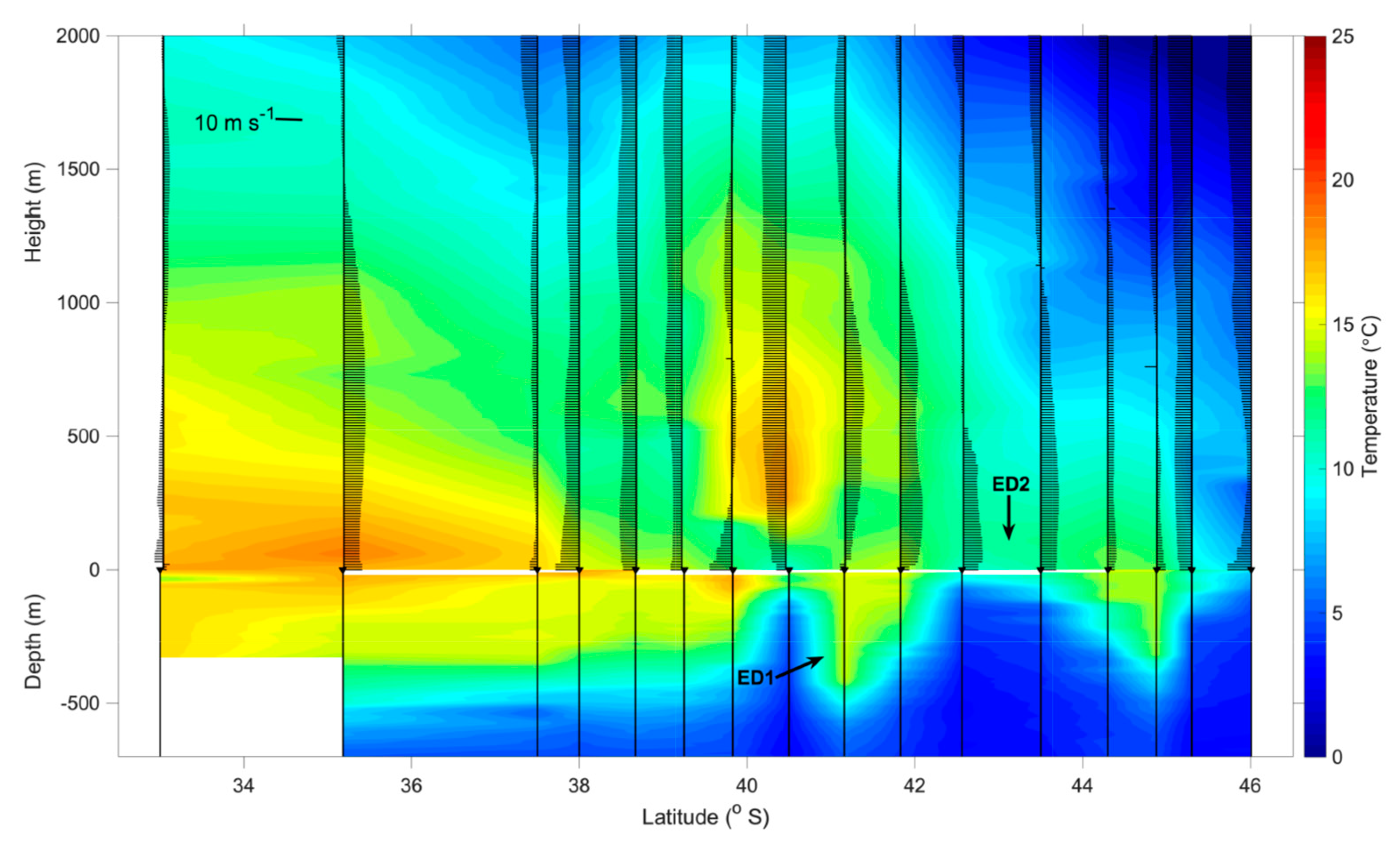
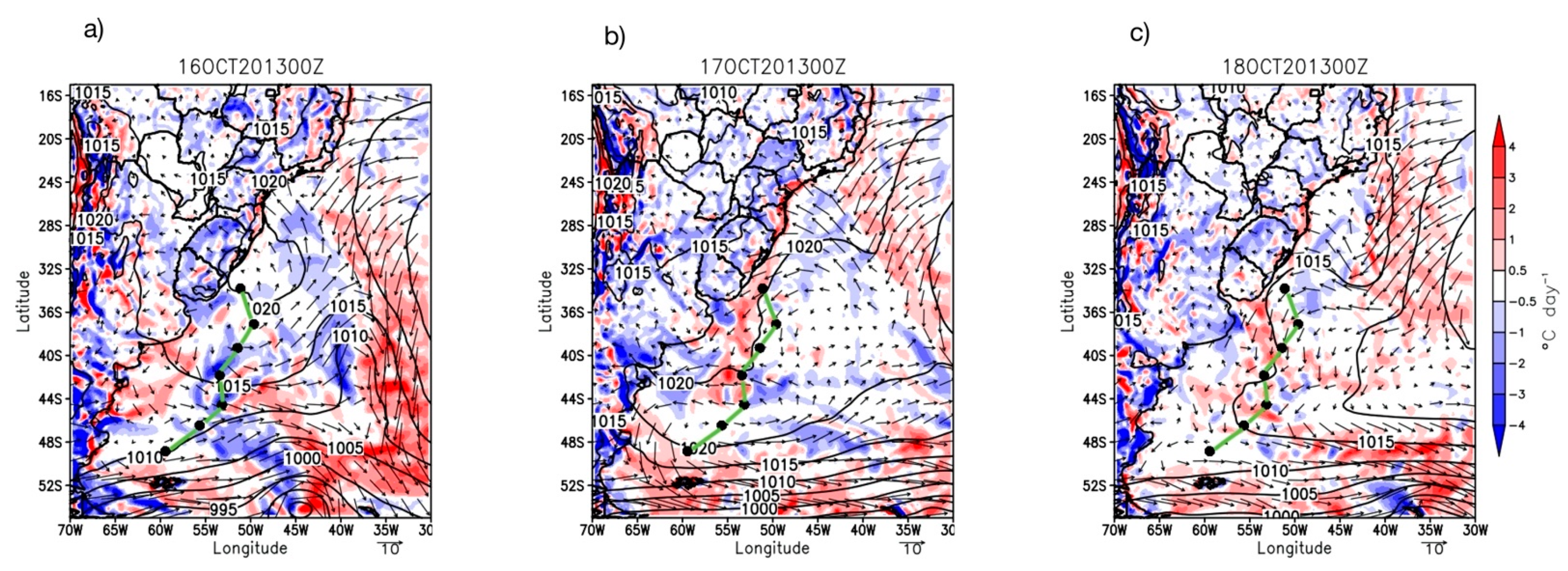
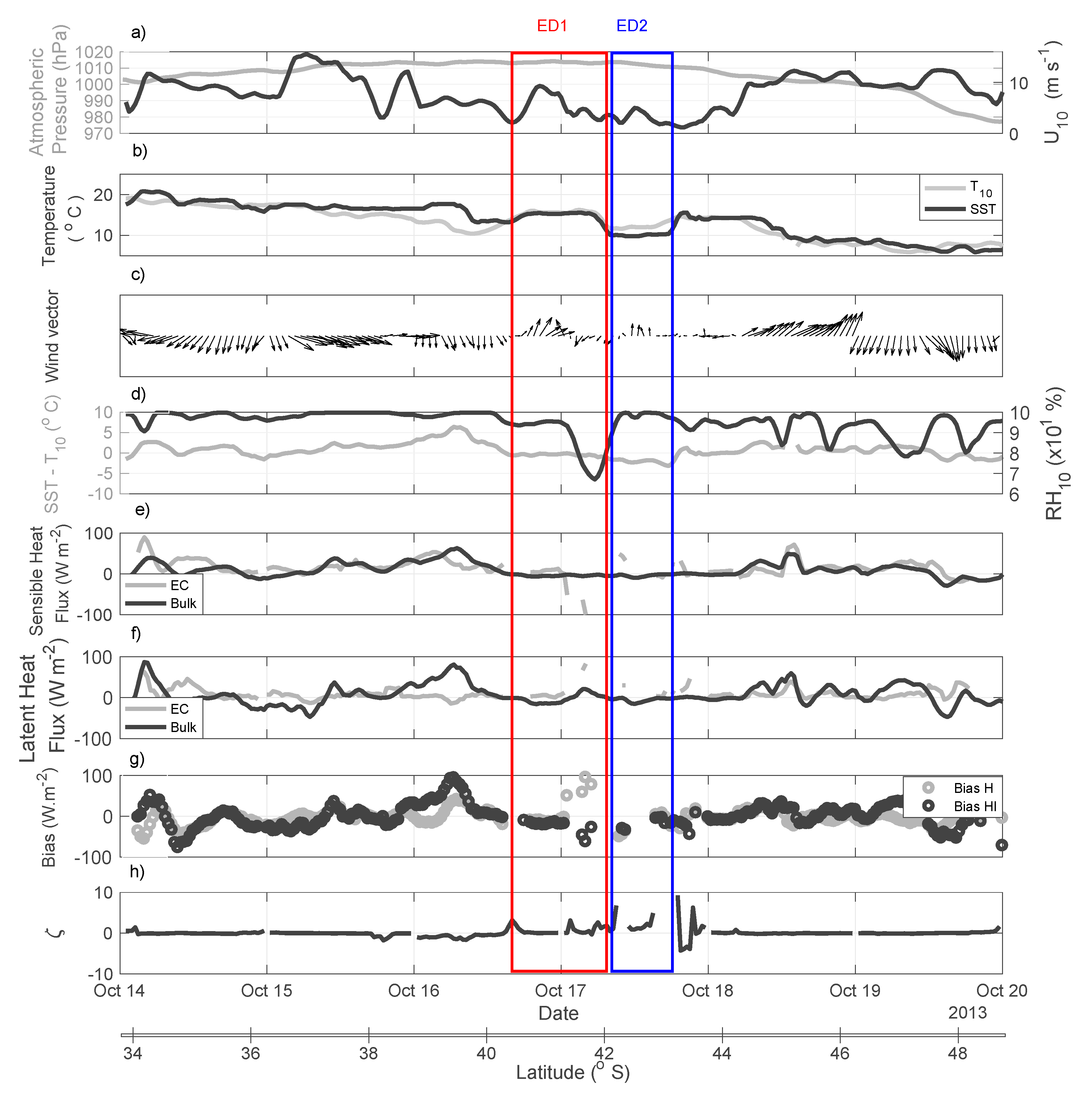
| Sensor | Model | Manufacturer |
|---|---|---|
| 3D sonic anemometer | CSAT3 | Campbell Scientific |
| Gas analyzer | LI-7200 | LI-COR |
| Pyranometer | CMP3-L | CKipp & Zonen |
| Magnetic compass | C100 | KVH Industries |
| GPS | GPS16X-HVS | Garmin |
| Multi-axis inertial motion unit | MotionPak II | Systron Donner |
| Barometric pressure sensor | CS106 | Vaisala |
| Thermohygrometer | HC2S3 | Campbell Scientific |
| ERA5 and Satellite | INTERCONF-32 | |||
|---|---|---|---|---|
| +ED1 | +ED2 | *ED1 | *ED2 | |
| Tair (°C) | 12.2 ± 2.75 | 8.4 ± 2.45 | 15.2 ± 0.9 | 12.2 ± 0.64 |
| Td (°C) | 7.1 ± 3.85 | 5.3 ± 3.29 | 12.9 ± 2.3 | 10.6 ± 1.2 |
| SST (°C) | 14.4 ± 0.89 | 9.7 ± 1.29 | 14.7 ± 0.9 | 10.1 ± 0.3 |
| SST-Tair (°C) | 2.2 ± 2.54 | 1.2 ± 1.83 | −0.4 ± 0.3 | −2.1 ± 0.5 |
| Hb (W m−2) | 10.3 ± 11.44 | 1.9 ± 7.44 | −3.5 ± 2.1 | −4.3 ± 2.9 |
| HEC (W m−2) | -- | -- | −10.3 ± 28.9 | 16.3 ± 23.5 |
| Hlb (W m−2) | 41.5 ± 29.55 | 19.9 ± 18.02 | −2.1 ± 10.8 | 5.6 ± 4.8 |
| HlEC (W m−2) | -- | -- | 15.2 ± 24.4 | 14.2 ± 12 |
| SLP (hPa) | 1019.7 ± 7.6 | 1019.8 ± 8.8 | 1013.5 ± 0.4 | 1012.2 ± 1.1 |
| SLA (mm) | 0.3 ± 0.07 | −0.5 ± 0.13 | -- | -- |
| ERA5 wind mag. (m s−1) | 7.5 ± 3.29 | 7.6 ± 3.18 | 5.1 ± 2.3 | 3.0 ± 1.1 |
| ASCAT wind mag. (m s−1) | 8.3 ± 3.4 | 7.4 ± 3.4 | ||
| WindSat wind mag. (m s−1) | 8.8 ± 2.4 | 7.4 ± 3.3 | ||
| ED1 | ED2 | Zapiola Rise | |
|---|---|---|---|
| Tair (°C) | 12.2 ± 2.8 | 8.4 ± 2.5 | 8.9 ± 2.4 |
| SST (°C) | 14.4 ± 0.9 | 9.7 ± 1.3 | 10.5 ± 0.6 |
| Hb (W m−2) | 10.3 ± 11.4 | 1.9 ± 7.4 | 3.7 ± 9.6 |
| Hlb (W m−2) | 41.5 ± 29.6 | 19.9 ± 18 | 26.7 ± 20.6 |
| ED1 | ED2 | |
|---|---|---|
| Tair (°C) | 37% | −6% |
| SST (°C) | 37% | −8% |
| Hb (W m−2) | 78% | −49% |
| Hlb (W m−2) | 55% | −25% |
Publisher’s Note: MDPI stays neutral with regard to jurisdictional claims in published maps and institutional affiliations. |
© 2021 by the authors. Licensee MDPI, Basel, Switzerland. This article is an open access article distributed under the terms and conditions of the Creative Commons Attribution (CC BY) license (https://creativecommons.org/licenses/by/4.0/).
Share and Cite
Souza, R.; Pezzi, L.; Swart, S.; Oliveira, F.; Santini, M. Air-Sea Interactions over Eddies in the Brazil-Malvinas Confluence. Remote Sens. 2021, 13, 1335. https://doi.org/10.3390/rs13071335
Souza R, Pezzi L, Swart S, Oliveira F, Santini M. Air-Sea Interactions over Eddies in the Brazil-Malvinas Confluence. Remote Sensing. 2021; 13(7):1335. https://doi.org/10.3390/rs13071335
Chicago/Turabian StyleSouza, Ronald, Luciano Pezzi, Sebastiaan Swart, Fabrício Oliveira, and Marcelo Santini. 2021. "Air-Sea Interactions over Eddies in the Brazil-Malvinas Confluence" Remote Sensing 13, no. 7: 1335. https://doi.org/10.3390/rs13071335
APA StyleSouza, R., Pezzi, L., Swart, S., Oliveira, F., & Santini, M. (2021). Air-Sea Interactions over Eddies in the Brazil-Malvinas Confluence. Remote Sensing, 13(7), 1335. https://doi.org/10.3390/rs13071335





